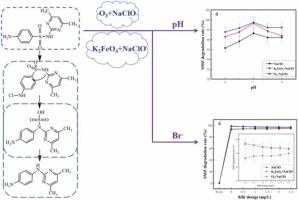Journal of Environmental Chemical Engineering ( IF 7.4 ) Pub Date : 2022-01-13 , DOI: 10.1016/j.jece.2022.107194 Yingzi Lin 1, 2 , Mingliang Zhou 2 , Gaoqi Wang 2 , Hao Li 2 , Yuhang Wei 2 , Yi Lou 2 , Dongyan Zhang 2 , Li Ji 2

|
Sulfamethazine (SMZ) is a pollutant that exists widely in the water environment, and it poses a threat to the environment and human health. However, the traditional water treatment process has very limited ability to remove SMZ. This paper studies the effectiveness of NaClO to remove SMZ after K2FeO4/O3 pre-oxidation and explores the main ways of chlorination degradation of SMZ. It also studies the influence of factors, such as the dosage of different pre-oxidants, chlorination time, NaClO dosage, pH, fulvic acid and Br- on the removal effect of SMZ. The results show that pre-oxidation process of O3 and K2FeO4 significantly increases the degradation rate of subsequent chlorinated SMZ, and the degradation rate of SMZ increases by 10.49% and 8.41% separately after pre-oxidation. When the pH value of the system is neutral, the three processes have the best degradation effect on SMZ. Among them, the O3-NaClO process has the highest degradation rate of SMZ, up to 98.69%. FA can inhibit both the degradation rate and the degradation rate of SMZ in O3/K2FeO4-NaClO system, and has the most obvious inhibition on the degradation of SMZ by O3 preoxidation, and the degradation rate decreases by 13.58%. The rise of Br- concentration will promote the efficiency of NaClO alone to oxidize SMZ, but will inhibit the chlorination degradation rate after pre-oxidation of O3/K2FeO4. The main pathways to chlorinate and degrade SMZ lie in the substitution of chlorine for amino groups to promote SMZ ring opening, intra-molecular Smiles-type rearrangement, and the subsequent desulfurization reactions.
中文翻译:

预氧化消毒工艺对磺胺二甲嘧啶的降解转化途径
磺胺二甲嘧啶(SMZ)是一种广泛存在于水环境中的污染物,对环境和人类健康构成威胁。然而,传统的水处理工艺去除SMZ的能力非常有限。本文研究了NaClO对K 2 FeO 4 /O 3预氧化后去除SMZ的效果,并探讨了氯化降解SMZ的主要途径。还研究了不同预氧化剂用量、氯化时间、NaClO用量、pH值、黄腐酸和溴-等因素对SMZ去除效果的影响。结果表明O 3和K 2 FeO 4的预氧化过程显着提高了后续氯化SMZ的降解率,预氧化后SMZ的降解率分别提高了10.49%和8.41%。当体系pH值为中性时,三种工艺对SMZ的降解效果最好。其中,O 3 -NaClO工艺对SMZ的降解率最高,可达98.69%。FA在O 3 /K 2 FeO 4 -NaClO体系中对SMZ的降解率和降解率均有抑制作用,其中O 3预氧化对SMZ的降解抑制最为明显,降解率下降13.58%。Br的崛起——浓度会促进NaClO单独氧化SMZ的效率,但会抑制O 3 /K 2 FeO 4预氧化后的氯化降解速率。SMZ氯化降解的主要途径是氯取代氨基促进SMZ开环、分子内Smiles型重排以及随后的脱硫反应。









































 京公网安备 11010802027423号
京公网安备 11010802027423号